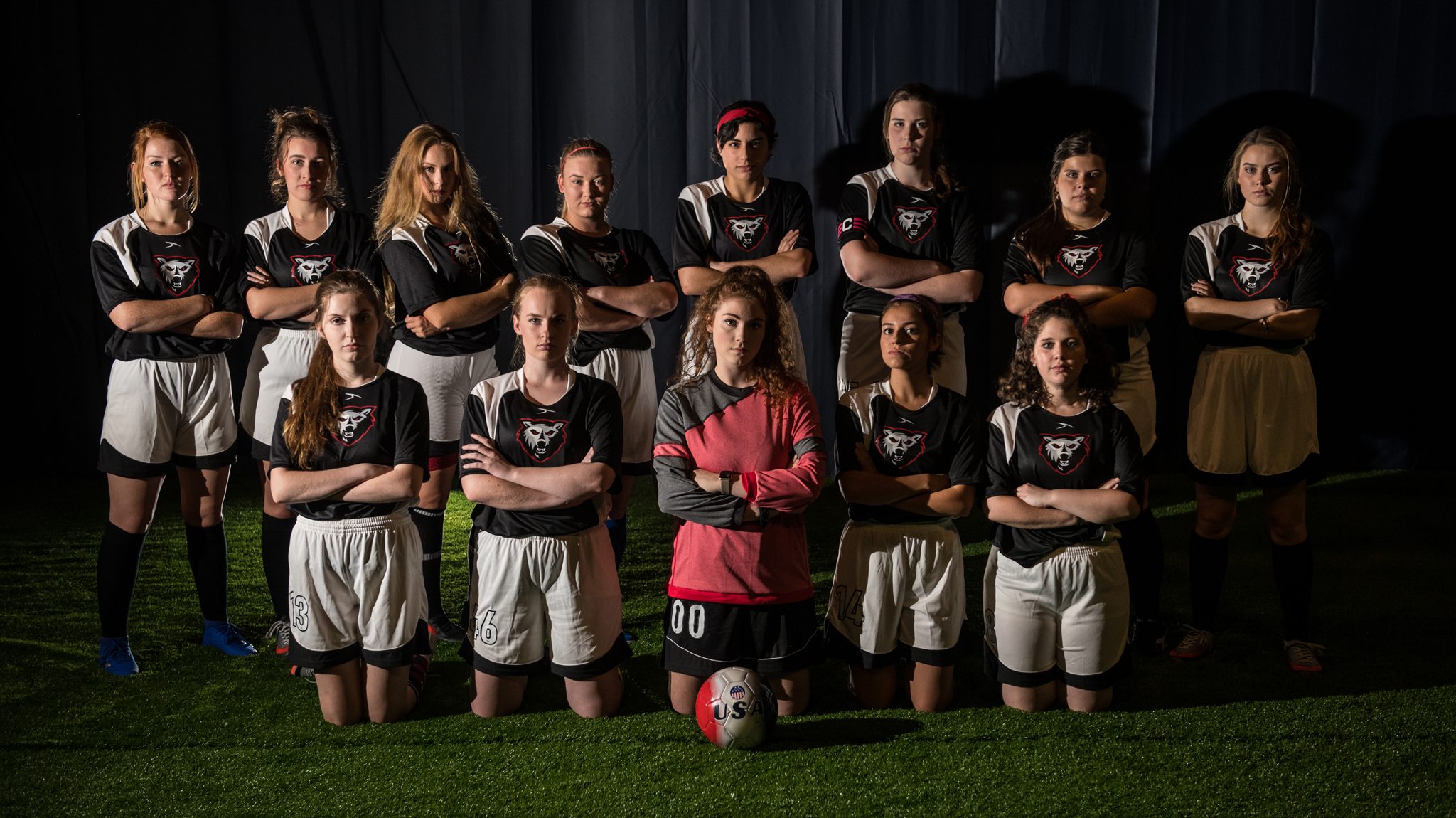
Members of a girls’ soccer team deliver insights into teen life as they chat during practices in the Ole Miss Theatre production of ‘The Wolves.’ The cast members and their understudies are (front row, from left) Elizabeth Adair, Emma Siler, Morgan Odom, Gabrielle Quintana and Madeline Colombo, and (back row) Olivia Crump, Hannah Bosworth, Erin Stanphill, Reagan-Mary Walsh, Robyn Medeiros, Claire Porter, Catherine Long and Lizzy Martin. Photo by Kevin Bain/Ole Miss Digital Imaging Services
OXFORD, Miss. – In the opening scene of “The Wolves,” the chatter of a group of teen-aged girls ricochets around an otherwise empty gymnasium, conversations overlapping as the uniformed young women sit in a circle on the AstroTurf, performing a routine of stretches and warmup moves so well-practiced as to appear perfunctory.
The Wolves are a high school girls’ indoor soccer team, but their chatter is more substantial than traditionally depicted teen-girl talk of clothes and boyfriends. It ping-pongs from genocide and civil liberties to parents and pregnancy and back again. It is the chatter of a group of adolescent girls trying to figure out who they are, both in the wider world and within the microcosm that is their team.
“I like the realness of it,” said Emma Siler, a University of Mississippi sophomore in the acting for stage and screen bachelor’s program from Brookhaven.
“This could be any group of teenage girls in any city anywhere. I like that you can look at it and go, ‘Yep, that’s been me.'”
“The Wolves” kicks off Ole Miss Theatre and Film‘s 2019-20 season at 7:30 p.m. Friday (Sept. 20) in Meek Auditorium and runs through Oct. 6, with performances at 7:30 p.m. Sept. 22 and 24-29, and Oct. 1-4, and 2 p.m. Sept. 22 and 28-29, and Oct. 6. No performances will take place on Sept. 21 or Oct. 5.
The opening night performance will be followed by a reception at the Oxford University Depot. Tickets are $20 each, with discounts available for UM students and employees, available at the UM Box Office or by calling 662-915-7411.
It’s an unconventional play in several ways: The action is confined to a generic multipurpose space and features the same warmup routine over a series of weekly practice periods; the players, dressed in matching uniforms, are referred to by number rather than name in all but one scene; and the ensemble cast carries on multiple conversations simultaneously.
Siler plays No. 46, new to the team and a bit of an outsider due to the fact that her family has moved around a lot and she doesn’t have the advantage of having played with the team for years like some of her teammates. (The fact that she reportedly lives with her mother in a “yogurt” – ahem, yurt – only enhances the impression of her otherness.)
But on the field, she quickly proves herself to be a serious competitor.
“I see a bit of myself in her because she is on the brink of that level – she’s not quite in the ‘in crowd’ – but she’s there and she’s trying to have a good time,” Siler said.
No. 46 is the archetypal outsider, and while most of the expected archetypes are represented in the team – the rebel, the captain, the innocent – as the drama unfolds, it becomes clear that these young women aren’t so neatly defined.
Guest director Sarah Flanagan, a stage combat trainer and fight choreographer and director who works primarily on the East Coast, appreciates that the play is “an effort to show young women as nuanced, actual characters dealing with adult problems.”
“We so often see teenage girls represented as catty or worrying about things like makeup or who’s going to take them to prom – these sort of silly or frivolous things,” Flanagan said. “What it’s really about, and where its value lies, is in showing us a more nuanced picture, one that has those layers.”

The conversations among the members of the Wolves soccer team delve deeper than stereotypical teen-girl talk of clothes and boyfriends to produce a nuanced look at young women tackling adult issues. The Ole Miss Theatre production of ‘The Wolves’ runs through Oct. 6 in Meek Auditorium. Photo by Kevin Bain/Ole Miss Digital Imaging Services
From a directing standpoint, the play presents a number of challenges.
“Even just the conceit that they’re supposed to be sitting in a circle stretching for every scene – how do we make that interesting?” said Flanagan, who addressed the issue by both beginning each scene at different points in the routine and rotating the circle so different characters are closest to the audience.
This second decision serves to address another major challenge in the script: the overlapping dialogue, which could be hard to follow without a focal point. By rotating the circle, Flanagan eases certain conversations to the forefront of the audience’s attention.
“It’s sort of directing your ear, in a way,” Flanagan said. “In film, we could just cut to different camera shots and decide who is being highlighted when. So this is a way of accomplishing the same idea, but through blocking.”
Perhaps the most obvious quirk of the script is that the characters will actually be using soccer balls on stage – though the chances of finding a full cast of actors who also happen to be soccer players are slim.
“The bonus of working with actors is that the folks who haven’t played soccer either have dance or movement training or have done stage combat before, so everybody has a good deal more physical awareness than just your average Joe or Jane off the street, and they’re able to take notes and make adjustments pretty well,” Flanagan said.
During the casting process, which took place in the spring 2019 semester, Flanagan looked for what she referred to as a kind of “foot logic” by setting up a series of dribbling exercises and watching to see which actors would naturally use both feet and the outsides as well as the insides of their feet.
“We don’t have time to train into anyone that both of their feet are valid options,” Flanagan explained. Once the team was cast, the lead actors and understudies were sent home with soccer balls to practice over the summer.
Only a third of the nine-member team had any previous soccer experience, so it helps that Flanagan had plenty – a dozen years, in fact, starting in first grade and moving up through junior varsity in junior high and varsity in high school.
“I don’t know if any of it will affect the end product of the show, but there are so many moments when it’s been useful … people in the audience who have played soccer or have played organized school sports are going to be like, ‘Ah, yeah, this reads as really accurate,'” Flanagan said.
Scenic designer Madison Morrow, a senior from Oklahoma City majoring in both theatre arts and general business, had played soccer as a young child, but she said later experience in volleyball and the resulting familiarity with indoor gyms informed her thinking in how to solve the design problem of representing a cavernous interior, much larger than would fit on the stage, without marooning the actors in an undefined segment of it.
“One of the main challenges I found was trying to create this world that both allowed the audience to see what the space is in addition to showing that this is ‘their world,'” Morrow explained.
“In the script, this is the world of these girls. It’s kind of isolated, but at the same time you don’t want to just make it a black hole – you want to still give a surrounding for the audience, to give context.”
Morrow’s solution was to include a high back wall, which anchors the space but still allows it to appear to span indefinitely off to either side. That wall and the AstroTurf blanketing the stage, in a green so bright it practically vibrates under the stage lights, are the primary visual hallmarks of the set – save for a port-a-potty and a short net that rings the playing area at the front of the stage.
“One of my first concept ideas was to have a net … to bring that safety element into it,” Morrow said. “In case there’s a stray ball that someone accidentally loses, it’s not going to roll off the edge of the stage.”
The simplicity of the set, the uniformity of the costumes and the near-anonymity of the players all serve to keep the dialogue front-and-center in the absence of visual distractions. Thus, the rawness of adolescence becomes more palpable and poignant.
“What I liked most about the show is that all of the characters have things going on, they all have things about them that are likable, and they all have at least one major life problem that’s affecting them throughout the course of the show,” Flanagan said.
“I like the idea that as an audience member, you can come in and identify with one or two of them and really follow them throughout the show and sort of root for your player,” Flanagan said. “It’s almost like a choose-your-own-adventure.”